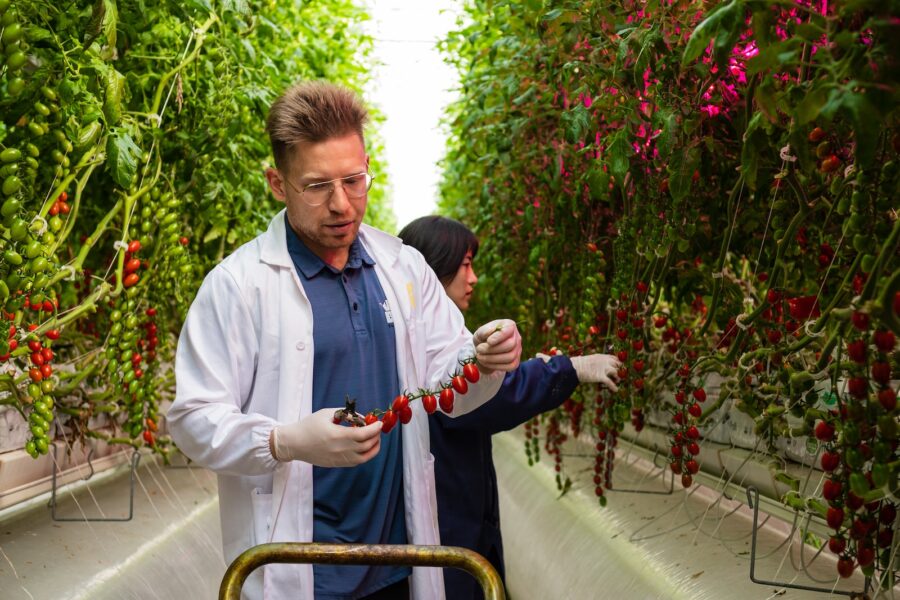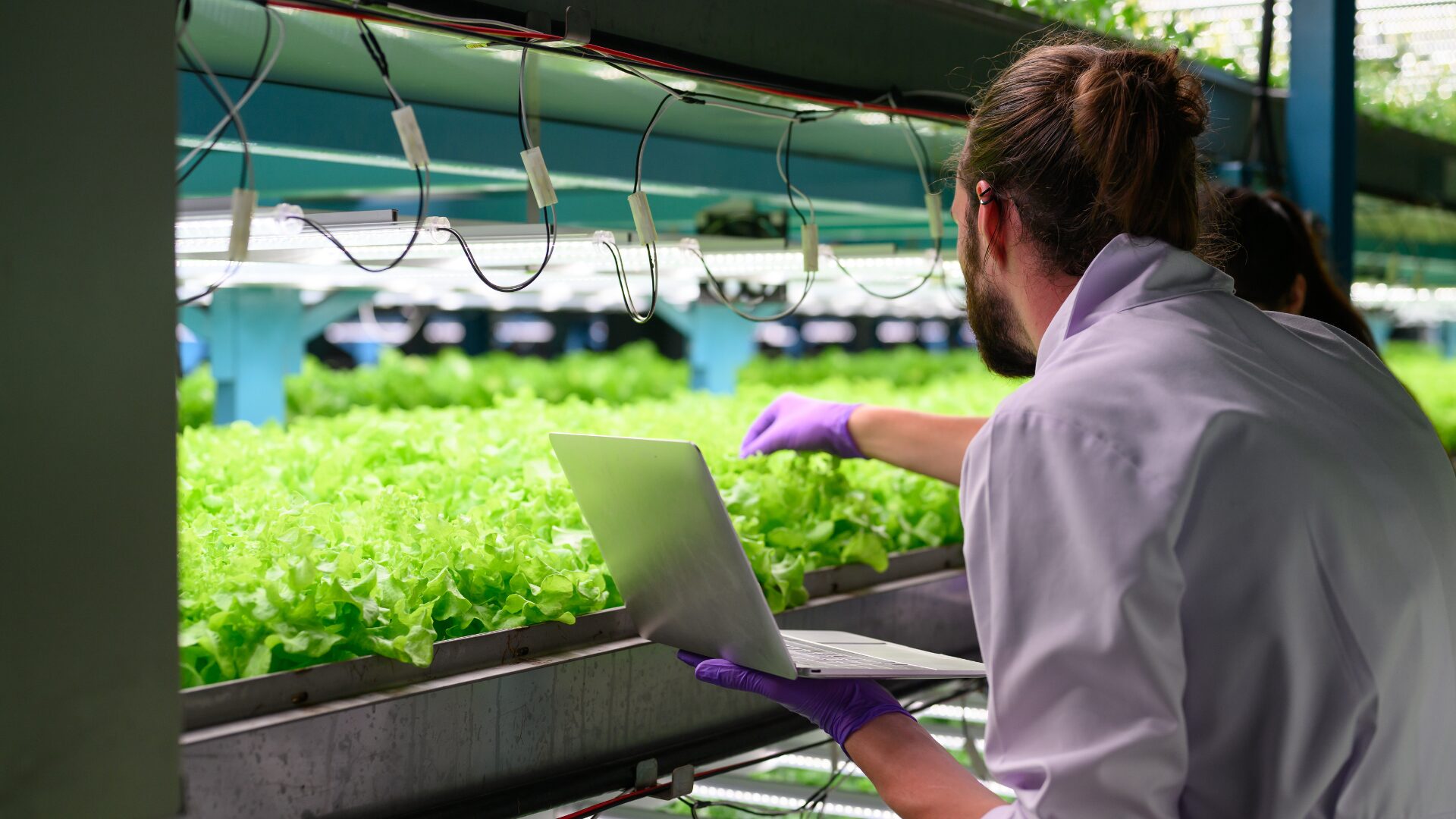Originally published in June 2023, Henry Gordon-Smith’s exploration of the bankruptcy at AeroFarms offered crisp context to the international state of controlled environment agriculture (CEA) before one of its most notable innovators declared bankruptcy. Later, in August, AeroFarms CMO and co-founder Marc Oshima joined Chris Campbell on The Food Institute podcast to discuss the company’s future and offer further insight into the state of CEA. The original article appears below.
Vertical farming, once hailed as a groundbreaking solution for sustainable agriculture, is currently facing a deluge of challenges.
Last week, AeroFarms, the most prominent player in the vertical farming industry, filed for Chapter 11 bankruptcy. This news comes in the wake of data revealing a staggering 91% year-on-year decline in venture capital investments in indoor farming, according to Pitchbook.
As a result, vertical farming businesses across Europe and North America are either shutting down or drastically reducing their operations. INFARM recently laid off 500 staff members, App Harvest is on the brink of financial collapse according to AFN, and Fifth Season’s robot farm has gone out of business. Meanwhile, Kalera, the company with the largest number of vertical farms globally, has also failed, as noted by The Packer.
A combination of exaggerated claims, excessive energy costs, and fundamental errors are leading to the downfall of vertical farming companies. While it’s true that the current economic downturn has affected many sectors and businesses …
Attributing the failure of vertical farming solely to a drying up of capital markets is an oversimplification.
To truly understand the current decline of vertical farming, we must delve deeper into the specific mistakes being made and explore the future prospects of this industry, including those noted below.
1. Product-Market-Fit
Product-market fit stands out as a primary reason behind the failure of vertical farms. While vertical farming offers advantages such as year-round production, reduced water usage, and elimination of pesticides, it is crucial to align crop selection with consumer demand. Some vertical farms have focused on niche or exotic crops that have limited market potential, resulting in oversupply or a lack of market interest.
On the other hand, some farms have pursued more popular products (like leafy greens and salad mixes) with plans to scale, but end up competing with lower-cost options that are already readily available (as exemplified by the failure of Local Garden, a small rooftop greenhouse in Vancouver). Vertical farms must carefully analyze market trends and consumer preferences to ensure they grow economically viable crops in high demand.
2. Variable Costs
Energy costs associated with artificial lighting, temperature control, and ventilation can be substantial for vertical farm companies, limiting profitability. Additionally, the maintenance and replacement of complex vertical farming systems, including hydroponic or aeroponic setups, add to the financial burden. Construction costs for vertical farms also tend to exceed budgets due to the novel nature of the technology and the limited number of construction experts and contractors experienced in this field.
Energy prices, which can be volatile in some markets, pose an additional risk, making it unwise for vertical farms to sign contracts with variable energy rates. To overcome these challenges, vertical farms must allocate extra time for meticulous planning, running various scenarios, and progressing steadily. A prudent approach contrasts with the “build fast and fail fast” mentality prevalent among Silicon Valley-like investors who have fueled the massive investment into vertical farming over the past five years.
Comparing two vertical farming facilities with different energy prices, it becomes evident that the operational expenses (OpEx) and the payback period are directly influenced.

Image 1: Assumption of Economic Units of a Vertical farm with $0.31/kWh using Agritecture Designer

Image 2: Assumption of Economic Units of a Vertical farm with $0.21/kWh using Agritecture Designer
3. Hype
Some investors have been attracted to the idea of sustainable agriculture without fully comprehending the complexities and challenges associated with vertical farming. Companies often make bold claims about reducing their carbon footprint to attract investors and consumers. However, most vertical farms today are powered by non-renewable energy sources and emit significantly more carbon than their field-based counterparts.
Hype inflates expectations, making it harder to accept any decline, such as in capital markets, sales, or increased energy costs. Engaging in hyped marketing and greenwashing is akin to a secret contract in which industry players, investors, and stakeholders deceive themselves and each other. This phenomenon poses the greatest cultural threat to vertical farming and has been eroding the sector’s foundations for nearly a decade.
To avoid this pitfall, stakeholders must exercise due diligence, conduct thorough feasibility studies, and commit to making specific and measurable sustainable commitments.
4. No Farmers, No Food, No Future
The absence of experienced agronomists or farmers in senior leadership positions is often a warning sign of a company that may struggle to succeed in farm operations. Effective crop cultivation in vertical farms necessitates a profound understanding of agronomy. While vertical farming focuses on controlled environments, it is vital to optimize growing conditions, nutrient delivery, and pest management to achieve desired yields and quality.
Some vertical farm ventures have faltered due to a lack of agronomy expertise, resulting in suboptimal crop performance and reduced market competitiveness. Prioritizing agronomy from the outset is crucial for both existing and new vertical farming operators to address this issue. Investors should also refrain from pouring money into flashy technologies that lack the necessary agronomic experience to support them.
5. Addicted to R&D
Many vertical farm startups prioritize research and development to such an extent that it hampers their operational scalability and commercial viability. While innovation is undeniably important, allocating excessive resources to R&D without establishing robust operational systems can impede a vertical farm’s success.
Striking a balance between innovation and implementation is essential, ensuring that R&D efforts align with the farm’s short-term and long-term goals. R&D expenditure should not exceed 20% of the company’s total budget, enabling efficient scaling and the achievement of profitability milestones.
6. Are you a technology company or a farm?
Vertical farms must strike a balance between leveraging technology and adhering to agricultural best practices to ensure successful operations. Rather than obsessing over becoming the next cutting-edge farming technology stack, vertical farms should prioritize their products, customers, branding, marketing, distribution, and operations. Resolving this identity crisis requires effective messaging from leadership to investors and team members.
The path to revolutionizing the agricultural industry through vertical farming has encountered significant hurdles. However:
It’s important to acknowledge that this isn’t a revolution but an evolution.
Through incremental, honest, and strategic improvements, vertical farming can emerge as a major supplier of leafy greens, berries, herbs, and medicinal crops near urban areas. This opportunity is significant enough to pursue responsibly without artificially inflating the concept of vertical farming beyond its true potential.
I’m not giving up on vertical farming yet and neither should you. Instead, we should foster more collaboration, practice better planning, and be honest about what is working, and what’s not.
Editor’s note: Henry Gordon-Smith is the Founder and CEO of Agritecture, an advisory services and tech firm focused on climate-smart agriculture, particularly urban and CEA.
The Food Institute Podcast
Following a string of bankruptcies and operational interruptions, the vertical farming industry seems in flux. AeroFarms CMO and co-founder Marc Oshima joined The Food Institute Podcast to discuss the company’s future following its Chapter 11 bankruptcy filing, plus future for prospects for the controlled environment agriculture (CEA) industry as a whole going forward.












